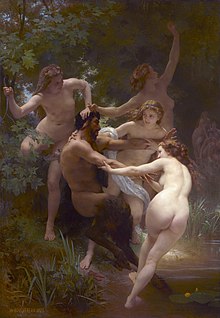Tree cult
Tree cult describes the worship of trees , groups of trees and sacred groves . They can be seen as the epiphany of mythological beings themselves, as their symbol or their seat. Tree worship is widespread among numerous peoples of the earth up to the present day.
history
The Encyclopedia Britannica cites the use of the jewelry through evergreen trees, wreaths and garlands as symbols of eternal life among the ancient Egyptians , Chinese and Hebrews .
In ancient times, the Mesopotamian and Indian cultures as well as Greeks , Teutons , Jews , Celts , Romans and Slavs knew consecrated trees or groves . In India, Buddha was born to his mother Maya under a sal tree and attained enlightenment ( bodhi ) under a bodhi tree ; Tree nymphs ( salabhanjikas ) play an important role in medieval sculpture in India .
In Germanic mythology , the Irminsul and the world ash Yggdrasil were known . Among the Teutons, the ash Wotan / Odin and the oak Þor / Donar were consecrated, like the famous Donar oak near Fritzlar . The Greeks also consecrated trees to Maia , the goddess of fertility.
Greeks and Romans were familiar with the idea that trees were inhabited by nymphs , the dryads , such as a laurel tree from Daphne , a linden tree from Philyra , a silver poplar from Dryope and a walnut tree from Karya . The oak grove of Dodona was a sanctuary. In Cyprus , the well and the cloth-hung fig tree in front of the Agia Solomoni catacombs heals eye ailments.
In the eastern Black Sea region of Colchis , Jason and his companions saw a multitude of corpses tied to the branches of willow , according to the Greek Argonaut legend . Burying dead men immediately was a bad habit for the Kolchians - the deceased were wrapped in bull skins and hung in trees outside the villages or towns. According to the Kolchian belief, the earth should first take its share of the dead before the remains were buried. The Georgian geographer Vakhoucht confirmed this part of the legend in the 18th century.
In Abkhazia , the belief in the forest goddess Mezıtha , the worship of old trees, especially oaks , has been documented in writing since ancient times and has been preserved despite the Christianization that was largely completed in the 6th century . Not far from each village there was a special oak tree under which meetings were held. Before wars, the population first visited this tree, tied colored strips of cloth to the branches and to their weapons and touched the tree trunk with the broadsides of their swords, while the oak was called for help and strength.
Abraham's camp sites are marked by trees. He had an apparition at the “Oak More” near Shechem . At the "oaks of Mamre", at Hebron , the birth of Isaac is announced to him. He planted a "tamarisk in Beer Sheva " and called on the Lord there. Hosea denounces this tree worship .
present
In the Celtic areas such as Ireland and Scotland, the "wish tree" or "rag (rag) tree" is the focus of worship. Wells or springs are accompanied by a "wish tree", which is hung with strips of cloth or rags, and recently also with mascots, which are supposed to convey wishes. Such a tree stands z. B. Near Clonfert Cathedral in County Galway . A coin tree stands near Ardmaddy House in Argyll an Bute , Scotland, a hawthorn traditionally associated with fertility is covered with hundreds of nailed coins.
Another wishing tree, which girls make wishes come true when a wreath woven from flowers is thrown into the branches and stuck in it, is in Brittany .
The custom of the Christmas tree spread from Germany in the 19th century all over the world and has been preserved in many countries to the present day.
In the Caucasus and in the northeast of Turkey known praying trees . Even today, in some areas of Asia, such as Bali , certain trees are considered sacred and are decorated with votive ribbons .
See also
literature
- Amots Dafni: Why Are Rags Tied to the Sacred Trees of the Holy Land? Economic Botany 56/4, 2002, pp. 315-327.
- Verena Eggmann, Bernd Steiner: Tree time. Magicians, myths and miracles. New insights into Europe's tree and forest history . Werd-Verlag, Zurich 1995, ISBN 3-85932-171-4 .
- Elisabeth Krenn: Sacred groves in ancient Greece. Origin, meaning and function . Diploma thesis, University of Graz 1993.
- Elmar Woelm: Mythology, meaning and nature of our trees (Edition Octopus). Monsenstein and Vannerdat , Münster 2007, ISBN 978-3-86582-407-3 .
Web links
- C. Wilfred Griggs: The Tree of Life in Ancient Cultures
- Lore Becker: The mythology of the trees
- Elmar Woelm: On the mythology, energy and healing properties of trees
- University of Göttingen: Thing and judicial linden tree
Individual evidence
- ↑ Christmas tree | Tradition & History. In: Encyclopedia Britannica . December 6, 2018, accessed December 17, 2018 .
- ↑ See also Wilhelm Mannhardt : Der Baumkultus der Teutons and their neighboring tribes. Berlin 1875.

